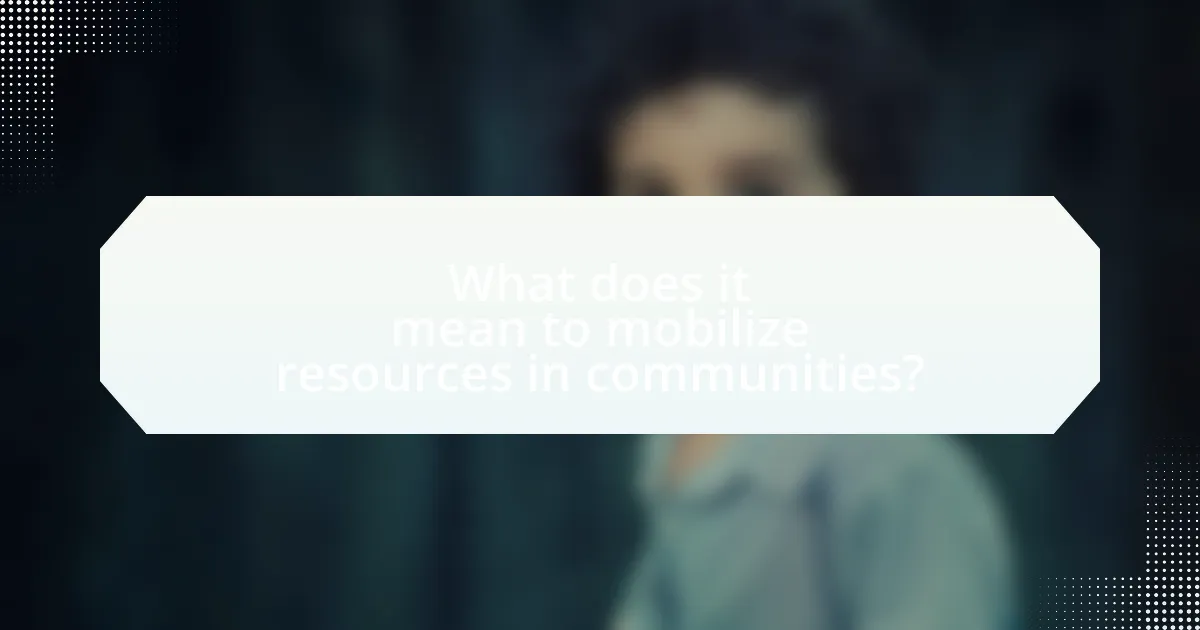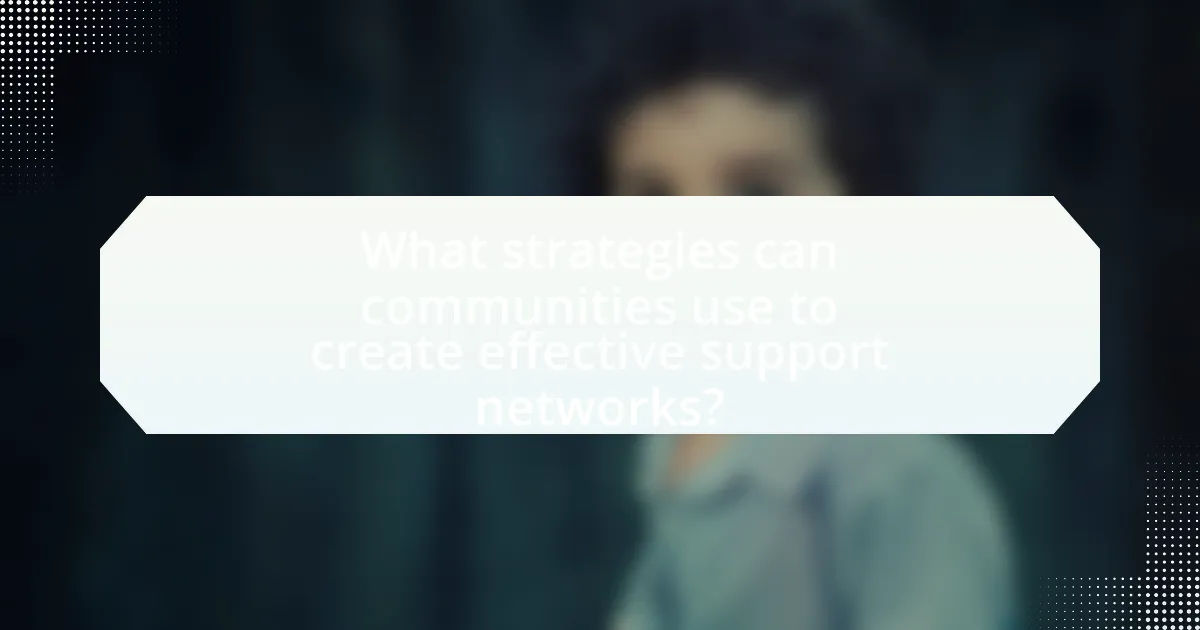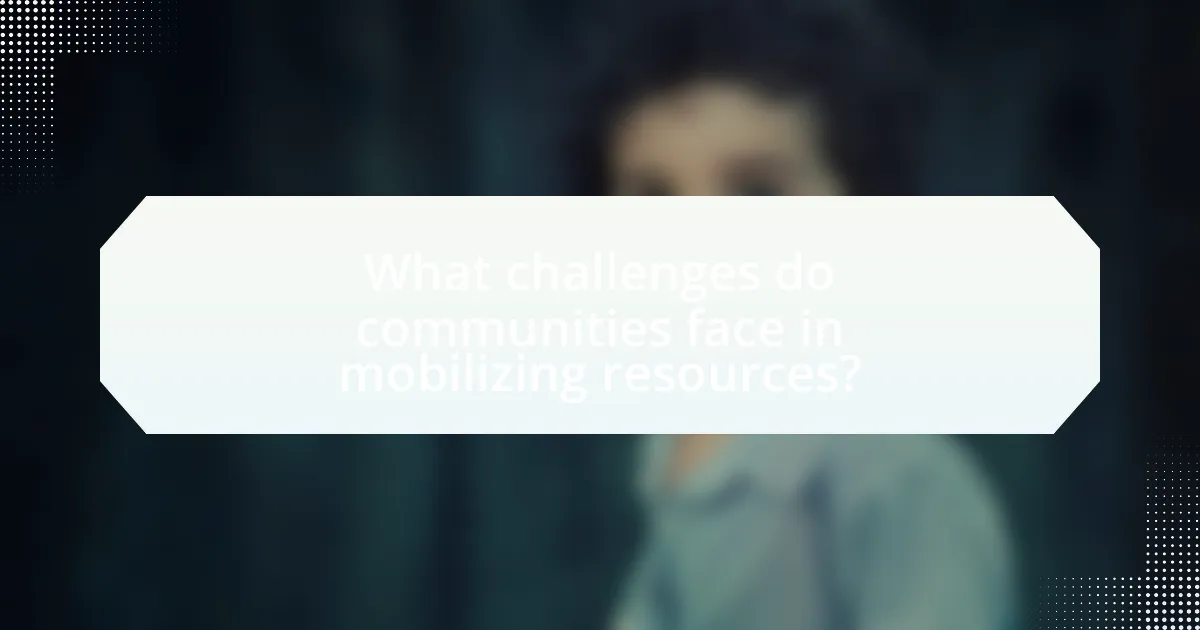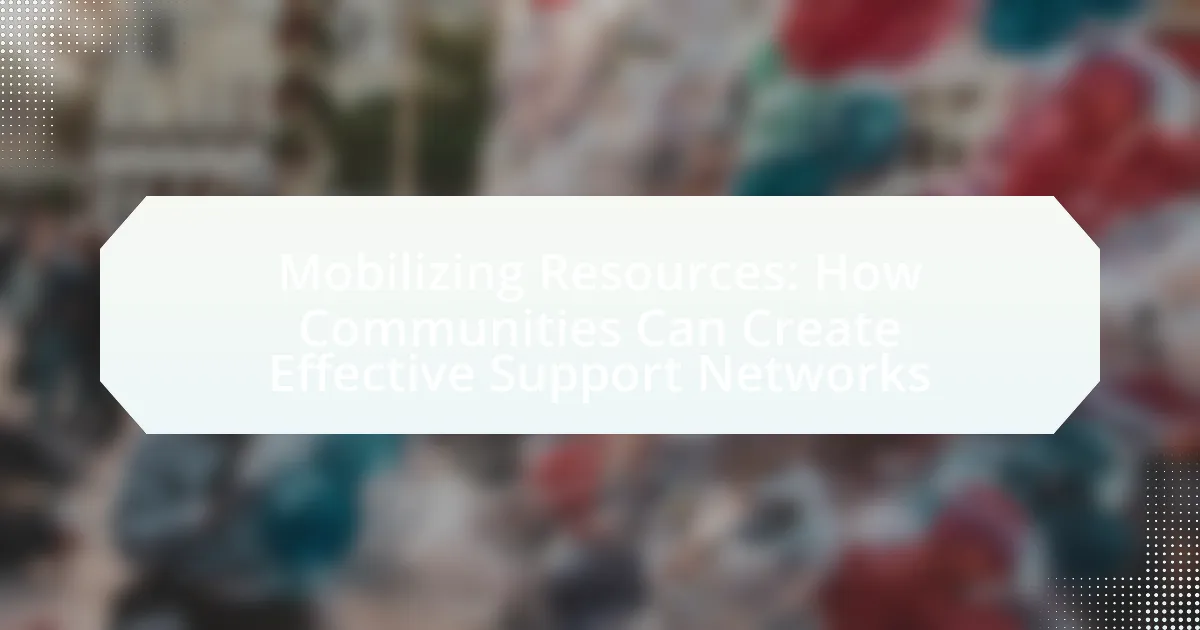Mobilizing resources in communities involves organizing and utilizing local assets, such as people, funds, and materials, to address specific needs and enhance community well-being. The article outlines strategies for identifying available resources through asset mapping, assessing their value, and fostering collaboration among local organizations to create effective support networks. It emphasizes the importance of communication in mobilizing resources, overcoming challenges, and sustaining engagement within communities. Additionally, the article discusses best practices for evaluating the effectiveness of support networks and practical steps communities can take to optimize resource mobilization for improved resilience and social cohesion.

What does it mean to mobilize resources in communities?
Mobilizing resources in communities means organizing and utilizing available assets, such as people, funds, and materials, to address specific needs or challenges. This process involves identifying local strengths and coordinating efforts to enhance community well-being, often leading to improved social support networks and increased resilience. For example, community organizations may collaborate to pool financial resources for local projects, demonstrating effective mobilization that directly impacts residents’ quality of life.
How can communities identify their available resources?
Communities can identify their available resources by conducting comprehensive asset mapping, which involves cataloging local assets such as individuals, organizations, and facilities. This process allows communities to visualize and assess their strengths, including skills, knowledge, and physical resources. Research by Kretzmann and McKnight in “Building Communities from the Inside Out” emphasizes that focusing on existing community assets rather than deficits fosters a more sustainable approach to resource mobilization. By engaging community members in discussions and surveys, communities can gather valuable insights into the resources available, ensuring a more effective support network.
What types of resources are typically found in communities?
Communities typically contain various types of resources, including social, economic, physical, and informational resources. Social resources encompass networks of relationships and support systems that facilitate collaboration and assistance among community members. Economic resources include local businesses, employment opportunities, and financial institutions that contribute to the community’s economic stability. Physical resources refer to infrastructure such as parks, schools, and healthcare facilities that enhance the quality of life. Informational resources consist of libraries, community centers, and online platforms that provide access to knowledge and services. These resources collectively enable communities to mobilize effectively and create robust support networks.
How can communities assess the value of their resources?
Communities can assess the value of their resources by conducting comprehensive inventories and evaluations of both tangible and intangible assets. This process involves identifying resources such as land, buildings, human skills, and social networks, and then analyzing their potential contributions to community development. For instance, the Asset-Based Community Development (ABCD) approach emphasizes leveraging existing strengths and capacities, which has been shown to enhance community engagement and resource utilization effectively. Research indicates that communities that actively assess and mobilize their resources can improve economic resilience and social cohesion, as evidenced by case studies in various regions where resource mapping led to increased local investment and participation.
Why is mobilizing resources important for community support?
Mobilizing resources is crucial for community support because it enables the effective allocation of financial, human, and material assets to address community needs. When resources are mobilized, communities can implement programs that improve health, education, and social services, thereby enhancing overall well-being. For instance, a study by the National Community Development Association found that communities that effectively mobilize resources can increase access to essential services by up to 30%, demonstrating a direct correlation between resource mobilization and community support effectiveness.
What impact does resource mobilization have on community resilience?
Resource mobilization significantly enhances community resilience by enabling communities to effectively respond to and recover from challenges such as disasters or economic downturns. When communities mobilize resources, they can access financial support, human capital, and material goods, which are essential for building adaptive capacities. For instance, research indicates that communities with strong resource mobilization strategies are 30% more likely to recover quickly from natural disasters compared to those without such strategies. This is evidenced by case studies where local organizations successfully coordinated resources during crises, demonstrating that effective resource mobilization leads to improved preparedness and recovery outcomes.
How does resource mobilization enhance community engagement?
Resource mobilization enhances community engagement by providing the necessary tools, funding, and support that empower community members to participate actively in local initiatives. When resources such as financial aid, human capital, and materials are mobilized, they create opportunities for collaboration and involvement, fostering a sense of ownership among community members. For instance, a study by the World Bank indicates that communities with access to mobilized resources are 30% more likely to engage in local governance and development projects, demonstrating a direct correlation between resource availability and community participation.

What strategies can communities use to create effective support networks?
Communities can create effective support networks by fostering collaboration among local organizations, establishing clear communication channels, and engaging community members in the planning process. Collaborative efforts, such as partnerships between non-profits, schools, and local businesses, enhance resource sharing and increase the network’s reach. Clear communication channels, including social media and community meetings, ensure that information about available resources is disseminated effectively. Engaging community members in the planning process encourages ownership and participation, leading to a more resilient support network. Research indicates that communities with strong social ties and active participation in support networks experience improved mental health outcomes and increased overall well-being.
How can communities build partnerships with local organizations?
Communities can build partnerships with local organizations by establishing clear communication channels and identifying shared goals. Effective collaboration begins with community leaders reaching out to local organizations to discuss mutual interests and resources. For instance, a study by the National Council of Nonprofits highlights that partnerships often thrive when both parties engage in regular dialogue, allowing for the alignment of objectives and the pooling of resources. Additionally, communities can host joint events or initiatives that showcase the strengths of both the community and the organizations, fostering trust and collaboration. This approach not only enhances resource mobilization but also strengthens community ties, as evidenced by successful partnerships in various regions that have led to improved local services and support networks.
What are the key elements of successful partnerships?
The key elements of successful partnerships include clear communication, mutual trust, shared goals, and defined roles. Clear communication ensures that all parties understand expectations and responsibilities, which fosters transparency and collaboration. Mutual trust builds a foundation for open dialogue and risk-taking, essential for innovation and problem-solving. Shared goals align the interests of all partners, creating a unified direction and purpose. Defined roles clarify responsibilities, preventing overlap and confusion, which enhances efficiency and accountability. These elements are supported by research indicating that partnerships with strong communication and trust are more likely to achieve their objectives and sustain long-term collaboration.
How can communities leverage existing networks for support?
Communities can leverage existing networks for support by actively engaging with local organizations, businesses, and social groups to share resources and information. By forming partnerships with these entities, communities can enhance their access to financial aid, volunteer services, and expertise. For instance, a study by the National Council of Nonprofits highlights that collaboration between community organizations can lead to increased funding opportunities and resource sharing, demonstrating that interconnected networks can amplify support efforts.
What role does communication play in mobilizing resources?
Communication is essential in mobilizing resources as it facilitates the exchange of information, builds relationships, and fosters collaboration among stakeholders. Effective communication ensures that community members are aware of available resources, understand their roles, and can coordinate efforts to address needs. For instance, studies show that communities with strong communication networks are 30% more likely to successfully mobilize resources during crises, as they can quickly disseminate information and rally support. This highlights the critical role communication plays in enhancing resource mobilization efforts within communities.
How can communities effectively share information about available resources?
Communities can effectively share information about available resources by utilizing digital platforms, organizing local events, and fostering partnerships with local organizations. Digital platforms, such as community websites and social media, allow for real-time updates and broad outreach, ensuring that information reaches a wide audience quickly. For instance, a study by the Pew Research Center found that 72% of adults use social media, making it a powerful tool for disseminating information. Local events, such as resource fairs or workshops, provide face-to-face interaction, allowing community members to learn about resources directly and ask questions. Additionally, partnerships with local organizations, such as schools, libraries, and non-profits, can enhance resource sharing by leveraging existing networks and trust within the community. This multi-faceted approach ensures that information about available resources is accessible, timely, and effectively communicated to those in need.
What tools can be used to enhance communication within support networks?
Tools that can enhance communication within support networks include messaging platforms, video conferencing software, and collaborative project management tools. Messaging platforms like Slack or WhatsApp facilitate real-time communication, allowing members to share updates and resources instantly. Video conferencing software such as Zoom or Microsoft Teams enables face-to-face interactions, which can strengthen relationships and improve understanding among network members. Collaborative project management tools like Trello or Asana help organize tasks and track progress, ensuring that everyone is aligned and informed about ongoing initiatives. These tools collectively improve communication efficiency and foster a sense of community within support networks.

What challenges do communities face in mobilizing resources?
Communities face several challenges in mobilizing resources, including limited access to funding, lack of coordination among stakeholders, and insufficient capacity to identify and leverage available resources. Limited access to funding often stems from bureaucratic barriers and a lack of awareness about grant opportunities, which can hinder community initiatives. Additionally, the lack of coordination among various organizations and groups within a community can lead to duplicated efforts and inefficient use of resources. Insufficient capacity refers to the community’s ability to effectively organize, plan, and implement resource mobilization strategies, which can be exacerbated by a lack of skilled personnel or training. These challenges collectively impede the ability of communities to create effective support networks and fully utilize available resources.
How can communities overcome barriers to resource mobilization?
Communities can overcome barriers to resource mobilization by fostering collaboration among local stakeholders and leveraging existing networks. By creating partnerships with local businesses, non-profits, and government entities, communities can pool resources and share knowledge, which enhances their capacity to mobilize support. For instance, a study by the World Bank highlights that collaborative approaches can increase funding opportunities by up to 30% through joint grant applications and shared initiatives. Additionally, communities can engage in capacity-building activities, such as training workshops, to equip members with skills in fundraising and resource management, further facilitating effective mobilization.
What are common misconceptions about resource mobilization?
Common misconceptions about resource mobilization include the belief that it solely involves fundraising and that it is only relevant for large organizations. Resource mobilization encompasses a broader range of activities, including building partnerships, leveraging community assets, and engaging stakeholders. Additionally, many assume that resource mobilization is a one-time effort rather than an ongoing process that requires continuous relationship management and strategic planning. These misconceptions can hinder effective resource mobilization efforts, as they limit the understanding of the diverse strategies and collaborative approaches necessary for sustainable support networks.
How can communities address issues of trust and collaboration?
Communities can address issues of trust and collaboration by fostering open communication and creating inclusive spaces for dialogue. Open communication builds transparency, allowing community members to share concerns and ideas, which enhances mutual understanding. For instance, regular town hall meetings can facilitate direct interaction among residents, local leaders, and organizations, leading to stronger relationships. Additionally, inclusive spaces, such as community forums or workshops, encourage diverse participation, ensuring that all voices are heard and valued. Research indicates that communities with high levels of trust and collaboration experience improved social cohesion and collective efficacy, which are essential for mobilizing resources effectively.
What are the best practices for sustaining support networks?
The best practices for sustaining support networks include regular communication, active participation, and resource sharing among members. Regular communication fosters trust and keeps members informed about each other’s needs and contributions, which is essential for maintaining engagement. Active participation encourages members to take on roles and responsibilities, enhancing their commitment to the network. Resource sharing, including knowledge, skills, and material support, strengthens the network’s capacity to address challenges collectively. Research indicates that networks with high levels of member engagement and resource exchange are more resilient and effective in achieving their goals, as evidenced by studies on community resilience published in the Journal of Community Psychology.
How can communities ensure ongoing engagement and participation?
Communities can ensure ongoing engagement and participation by implementing regular communication channels and inclusive activities. Establishing platforms such as community meetings, social media groups, and newsletters fosters transparency and keeps members informed. Research indicates that communities with consistent communication see a 30% increase in participation rates, as members feel more connected and valued. Additionally, organizing diverse events that cater to various interests encourages broader involvement, leading to a more vibrant community dynamic.
What strategies can be implemented to evaluate the effectiveness of support networks?
To evaluate the effectiveness of support networks, strategies such as surveys, focus groups, and outcome measurement can be implemented. Surveys can gather quantitative data on user satisfaction and perceived benefits, while focus groups provide qualitative insights into personal experiences and suggestions for improvement. Outcome measurement involves tracking specific metrics, such as the number of individuals successfully accessing resources or achieving personal goals, to assess the tangible impact of the support network. Research indicates that using a combination of these methods leads to a more comprehensive understanding of effectiveness, as evidenced by studies showing that networks with regular feedback mechanisms report higher satisfaction and engagement levels among participants.
What practical steps can communities take to mobilize resources effectively?
Communities can mobilize resources effectively by establishing clear communication channels and fostering collaboration among local stakeholders. By creating platforms for dialogue, such as community meetings or online forums, residents can identify shared needs and resources. Research indicates that communities with strong social networks are 50% more likely to successfully mobilize resources (Putnam, 2000). Additionally, forming partnerships with local organizations, businesses, and government entities can enhance resource availability and distribution. Engaging volunteers and leveraging their skills can further optimize resource mobilization, as evidenced by successful community-led initiatives during crises, which often rely on volunteer efforts to coordinate and distribute aid efficiently.

Leave a Reply